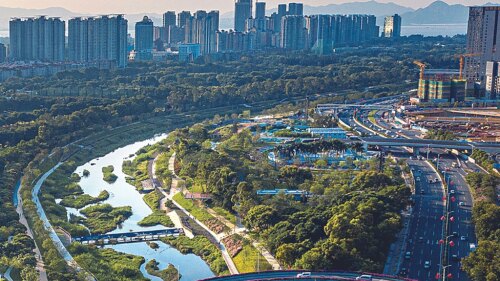What can cities do with aging, obsolete infrastructure that becomes not only useless but also dangerous? All over the United States, communities are finding creative ways to transform these liabilities into valuable amenities that engage and revitalize neighborhoods, attract tourists, and enhance economic vitality. At the annual Washington Real Estate Trends conference sponsored by ULI’s Washington, D.C., district council, panelists presented inspiring examples of several successful projects in the nation’s capital and beyond.
“The theme for this year’s Trends conference was ‘Common Ground: Building Partners, Projects, and Potential,’ ” said Yolanda Cole of Hickok Cole Architects, Trends Conference cochair. “Here in Washington and throughout the world, our politics are rigidly polarized and there seems to be little for collaboration as we face an increasingly complex world supported by outdated infrastructure.”
“But at the same time,” noted cochair Anthony Chang of Washington REIT, “technology and globalism have generated completely new ways of doing business, and have unleashed an era of creativity in the ways that we conduct commerce, construct buildings, design public places, and even reuse aging infrastructure.”
ULI Washington Trends 2015 Audio: From Eyesore to Eye Candy: When Aging Infrastructure Gets a Make Over from ULI Washington on Vimeo.
Leading the infrastructure panel was Scott Kratz, executive director of the 11th Street Bridge Park, who said: “Cities are being defined by public spaces. George Washington chose this area for the new country’s capital because of its location at the confluence of two rivers, the Potomac and Anacostia; yet today, we don’t define ourselves by our engagement with these rivers.”
All of that is about to change as a former span of the city’s 11th Street Bridge, connecting the city’s historic Capitol Hill and Anacostia neighborhoods, is transformed into the city’s first elevated park. Funded by the government of Washington, D.C., and a variety of private and institutional organizations including ULI and the ULI Foundation, the 11th Street Bridge Park will be a new venue for healthy recreation, environmental education, and the arts.
Last October, following a seven-month nationwide competition and with input from more than 1,000 citizens, OMA + OLIN was selected as the design team for the new elevated park. The former freeway bridge deck will be removed and replaced with a new deck, composed of two sloped components that intersect in the middle of the span, creating a giant “X” shape.
“Our design creates a literal intersection and a dynamic, multilayered amenity for both sides of the river,” explained OMA partner-in-charge Jason Long in a statement. “It simultaneously functions as a gateway to both sides of the river, a lookout point with expansive views, a canopy that can shelter programs, and a public plaza where the two paths meet. The resulting form of the bridge creates an iconic encounter, an ‘X’ instantly recognizable within the capital’s tradition of civic spaces.” The new park will offer such amenities as a playground, a kayak and canoe launch, an environmental education center, public art, a café, and performance spaces.
Obsolete infrastructure was also the inspiration for the SteelStacks arts and cultural campus, located on the site of Bethlehem Steel, which shut its plant in 1995 and declared bankruptcy in 2002. Winner of a 2014 ULI Global Award for Excellence, this 9.5-acre (3.8 ha) campus sits within Bethlehem Works, a 126-acre (51 ha) development that was established as a 20-year tax increment finance (TIF) district in 2000. With a variety of public and nonprofit funding sources, SteelStacks opened in 2011 with the former plant’s 20-story-tall blast furnaces as a dramatic backdrop.
Kassie Hilgert, president and CEO of ArtsQuest, described how her organization has contributed to this new economic engine with the ArtsQuest Center at SteelStacks, a performing arts center offering concerts, films, dance, comedy, and other events throughout the year. The SteelStacks campus also includes the Levitt Pavilion, offering some 50 free concerts per year; Air Products Town Square, which includes the TD Community Stage; the Bethlehem Visitor Center, presented by St. Luke’s University Health Network; and PNC Plaza, home to the main stage for Musikfest, the nation’s largest free music festival, as well as Christkindlmarkt and Oktoberfest, based on the heritage of Bethlehem’s many German immigrants. Altogether, the SteelStacks campus serves some 1.3 million people every year and generates millions of dollars in economic activity.
“A lot of people wanted to tear down the blast furnaces after the plant closed, but we took inspiration from places like Volkingen Hütte in Germany, where similar structures are now the center of a UNESCO World Heritage Site,” Hilgert explained. “These types of furnaces will never be built again, and they were never before open to the public. SteelStacks, the largest brownfield redevelopment in the U.S., has a number of installations and programs that pay homage to the contributions and sacrifices of the plant’s former steelworkers.”
A public/private spinoff of the National Endowment for the Arts’ Our Town grant program, which funded a dynamic fire sculpture located within SteelStacks, ArtPlace America is focused on “making places creatively,” explained Jamie Hand, director of research strategies. With a mission limited to ten years, the group has funded creative place-making projects throughout the country. In Fargo, North Dakota, retention ponds used to control flooding of the Red River will soon be available for a variety of public uses. In Los Angeles, another ArtPlace grant is facilitating the transformation of the Los Angeles River from a concrete ditch to an accessible urban amenity. All of these projects, panelists explained, are geared toward creating sustainable communities—but they also have substantial economic benefits, including increasing property values.





